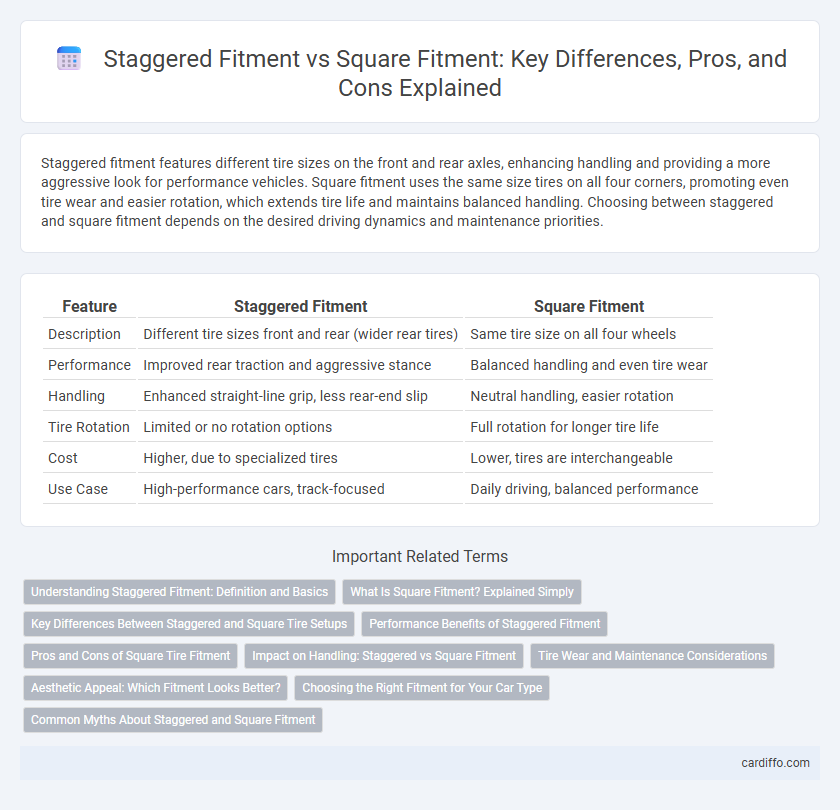Staggered fitment features different tire sizes on the front and rear axles, enhancing handling and providing a more aggressive look for performance vehicles. Square fitment uses the same size tires on all four corners, promoting even tire wear and easier rotation, which extends tire life and maintains balanced handling. Choosing between staggered and square fitment depends on the desired driving dynamics and maintenance priorities.
Table of Comparison
| Feature | Staggered Fitment | Square Fitment |
|---|---|---|
| Description | Different tire sizes front and rear (wider rear tires) | Same tire size on all four wheels |
| Performance | Improved rear traction and aggressive stance | Balanced handling and even tire wear |
| Handling | Enhanced straight-line grip, less rear-end slip | Neutral handling, easier rotation |
| Tire Rotation | Limited or no rotation options | Full rotation for longer tire life |
| Cost | Higher, due to specialized tires | Lower, tires are interchangeable |
| Use Case | High-performance cars, track-focused | Daily driving, balanced performance |
Understanding Staggered Fitment: Definition and Basics
Staggered fitment refers to a tire and wheel setup where the rear tires are wider than the front tires, enhancing traction and stability, especially in high-performance and rear-wheel-drive vehicles. This configuration improves cornering grip and prevents oversteer by optimizing weight distribution and tire contact patch dynamics. Understanding staggered fitment involves recognizing its impact on handling characteristics and the need to match compatible tire sizes for optimal performance and safety.
What Is Square Fitment? Explained Simply
Square fitment refers to using identical tires on all four wheels, with the same size, tread pattern, and sometimes even the same brand, promoting uniform wear and easier tire rotations. This setup enhances balanced handling and provides a smoother ride, especially beneficial for daily drivers and vehicles without extreme performance demands. Compared to staggered fitment, which uses different sizes on front and rear axles for specialized handling, square fitment simplifies maintenance and maximizes tire lifespan.
Key Differences Between Staggered and Square Tire Setups
Staggered tire setups feature larger, wider tires on the rear axle compared to the front, enhancing rear-wheel traction and stability, especially in high-performance or rear-wheel-drive vehicles. Square setups utilize identical tire sizes and width on all four wheels, promoting uniform handling, easier rotation, and extended tire life. Key differences center on performance benefits, tire wear patterns, and compatibility with vehicle drivetrain and suspension design.
Performance Benefits of Staggered Fitment
Staggered fitment, featuring wider rear tires than the front, enhances traction and cornering stability by optimizing weight distribution and grip during acceleration and high-speed turns. This setup improves handling performance by reducing understeer and providing better rear-end stability in powerful rear-wheel-drive vehicles. Increased rear tire width also contributes to improved straight-line acceleration and braking efficiency compared to square fitment.
Pros and Cons of Square Tire Fitment
Square tire fitment, where all four tires are the same size and type, offers improved tire rotation flexibility and even wear distribution, enhancing overall tire longevity. This setup provides consistent handling and traction balance, especially beneficial in daily driving and moderate performance conditions. However, it may limit performance tuning options and reduce cornering grip compared to staggered fitment, which uses different sizes front and rear for optimized traction and responsiveness.
Impact on Handling: Staggered vs Square Fitment
Staggered fitment, with wider rear tires than the front, enhances traction during acceleration and improves cornering stability by offering greater rear grip. Square fitment, featuring identical tire sizes on all four corners, promotes balanced handling and predictable tire wear, facilitating better rotation options. The choice between staggered and square fitment significantly impacts vehicle dynamics, with staggered setups favoring rear traction and square setups optimizing overall handling balance.
Tire Wear and Maintenance Considerations
Staggered fitment, with different tire sizes on the front and rear axles, often causes uneven tire wear due to varying rolling diameters and limited tire rotation options, necessitating more frequent inspections and potential replacements. Square fitment uses identical tire sizes on all four wheels, promoting even tire wear and simplifying maintenance through regular tire rotations, which can extend tire lifespan and improve overall vehicle performance. Proper alignment and balanced inflation are critical in both setups to minimize irregular wear patterns and ensure safe handling.
Aesthetic Appeal: Which Fitment Looks Better?
Staggered fitment features larger wheels on the rear axle, creating a more aggressive and dynamic stance favored by sports car enthusiasts for enhanced visual impact. Square fitment uses identical wheel and tire sizes on all four corners, offering a balanced and symmetrical appearance appreciated for its clean and purposeful look. Many drivers prefer staggered fitment for its bold aesthetic appeal, while others favor the uniformity and simplicity of a square setup.
Choosing the Right Fitment for Your Car Type
Staggered fitment, featuring wider tires on the rear axle, enhances traction and handling for rear-wheel-drive sports cars and performance vehicles. Square fitment, with uniform tire sizes on all four corners, promotes even tire wear and consistent handling, ideal for all-wheel-drive and daily-driven cars. Selecting the right fitment depends on your vehicle's drivetrain and driving style to maximize performance and tire longevity.
Common Myths About Staggered and Square Fitment
Common myths about staggered fitment claim it drastically improves handling, though benefits depend on specific vehicle dynamics rather than tire arrangement alone. Square fitment skeptics argue it causes uneven tire wear, but proper rotation and alignment mitigate these issues effectively. Both staggered and square fitments have unique advantages that vary based on vehicle type, driving conditions, and performance goals.
Staggered fitment vs square fitment Infographic

 cardiffo.com
cardiffo.com